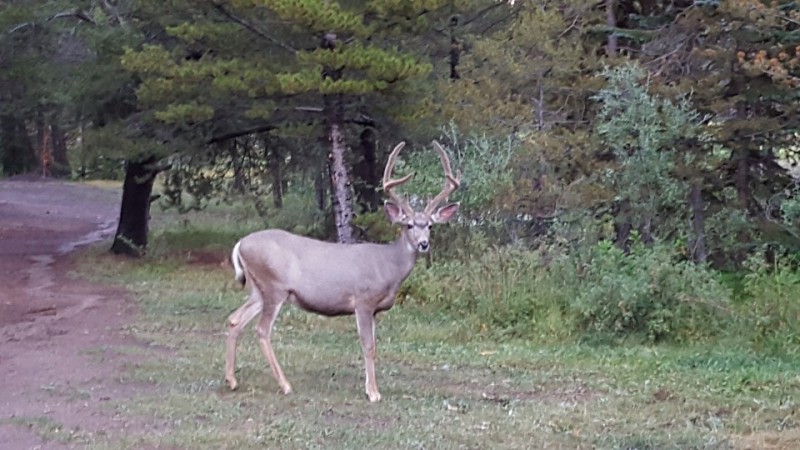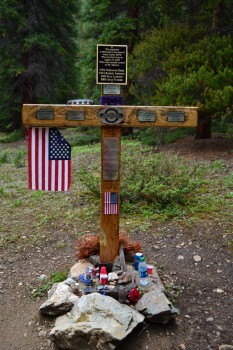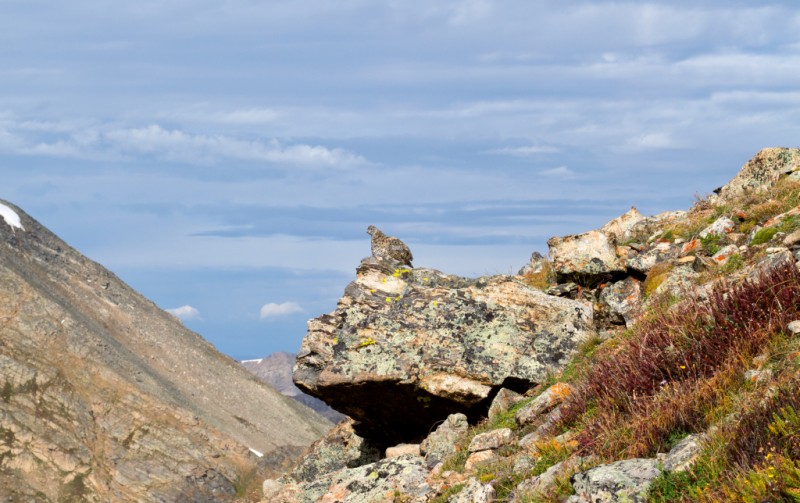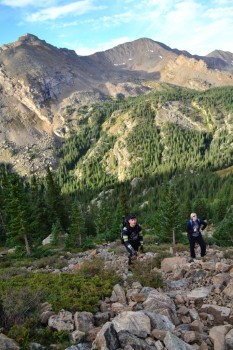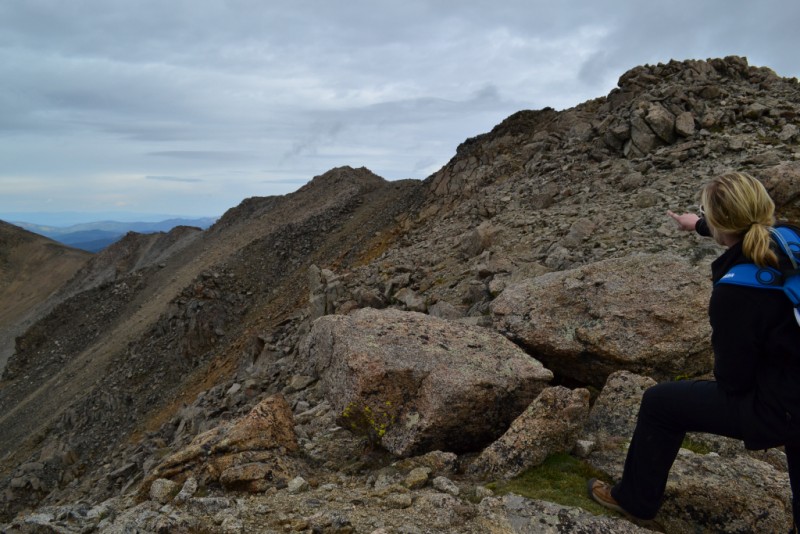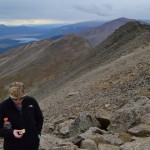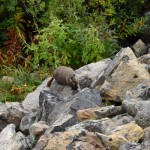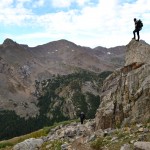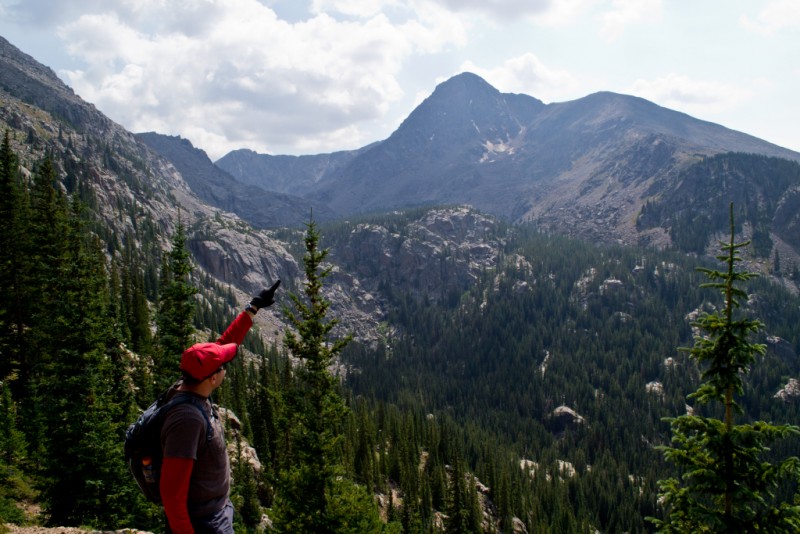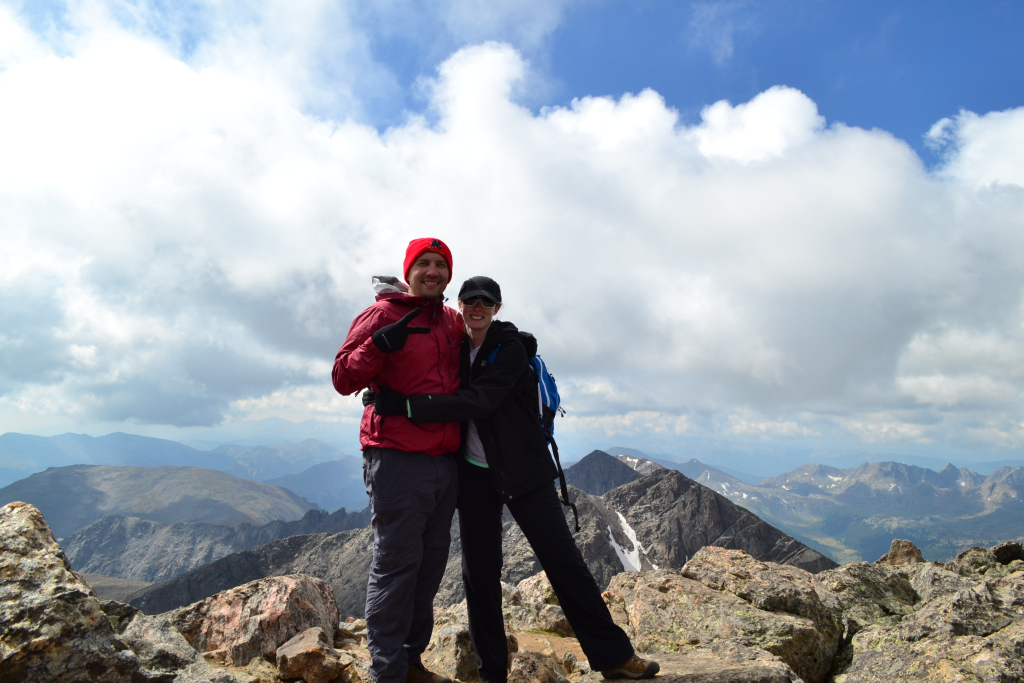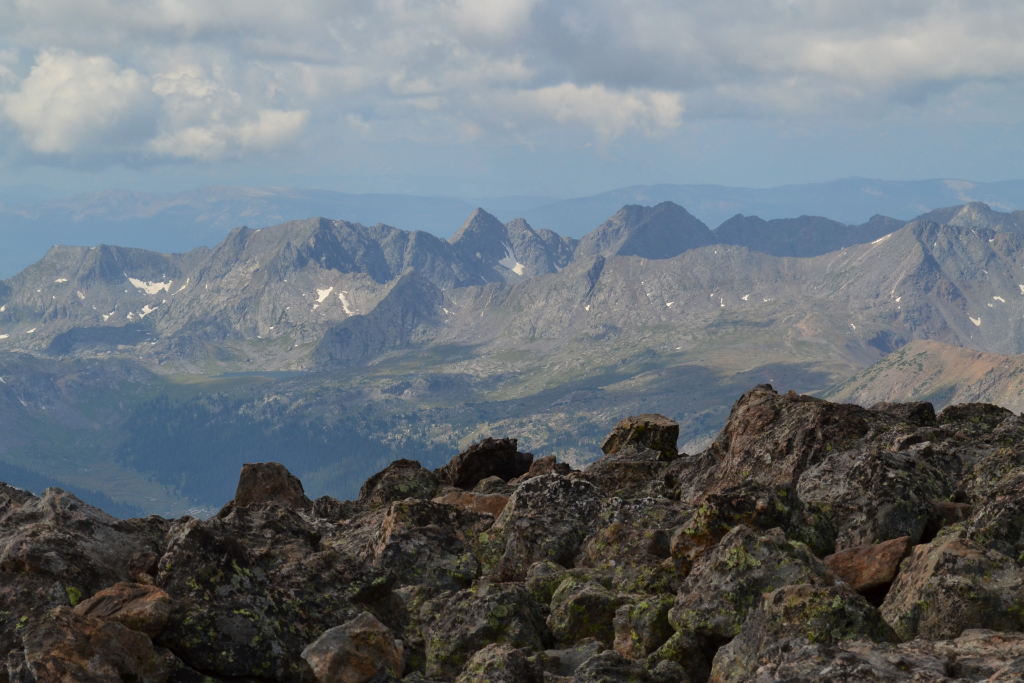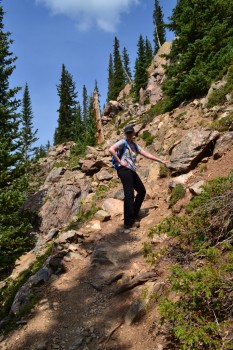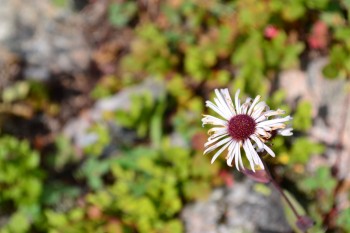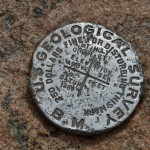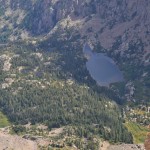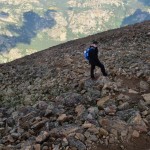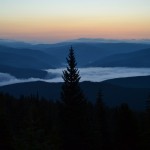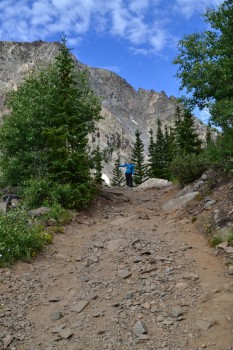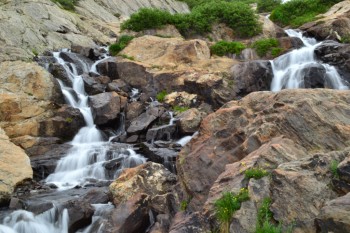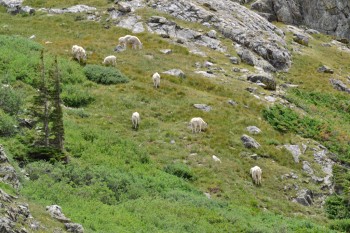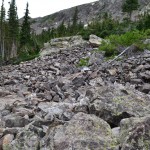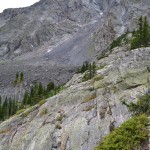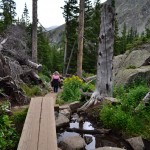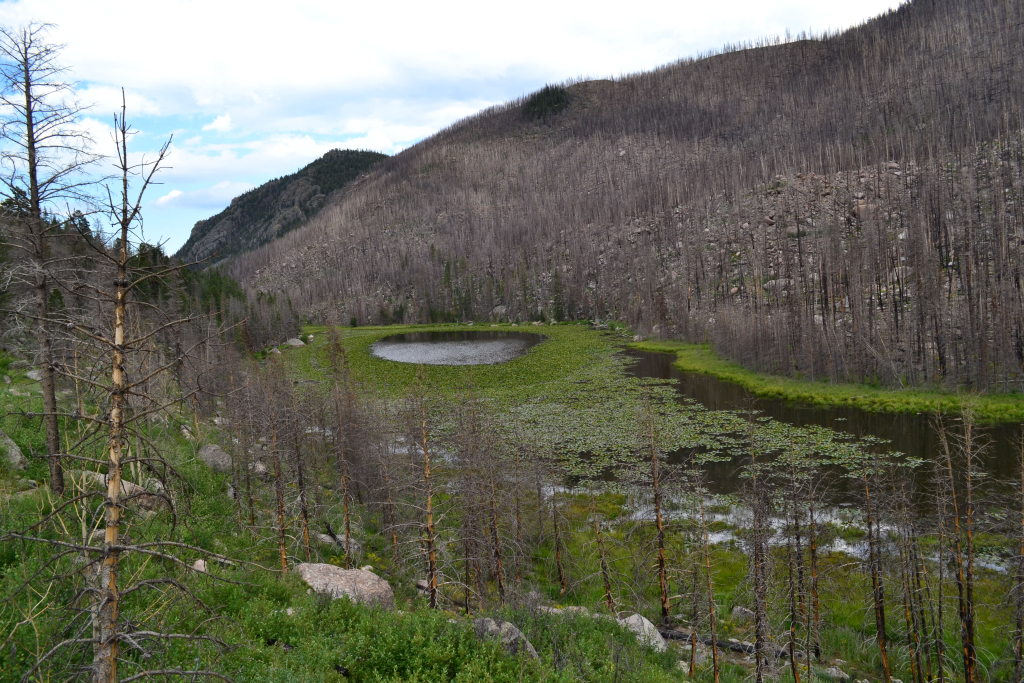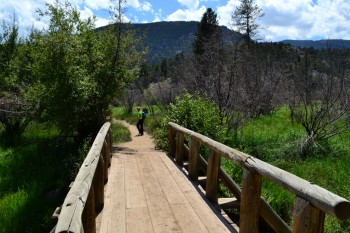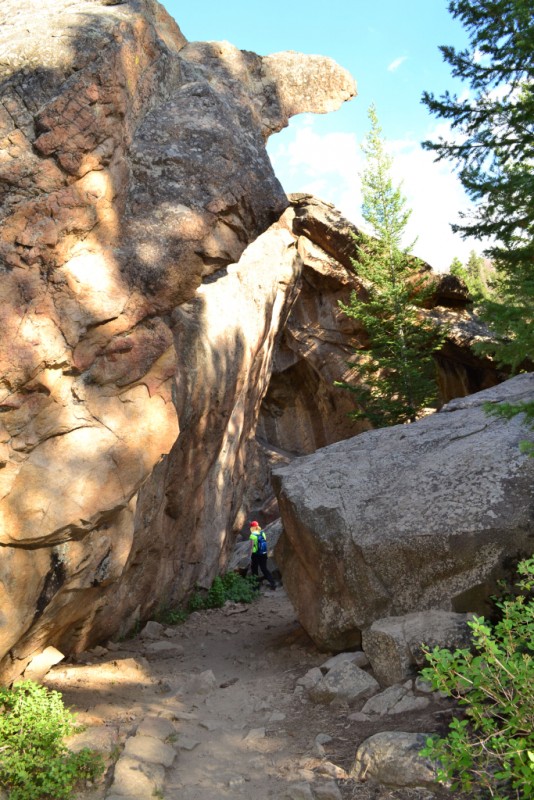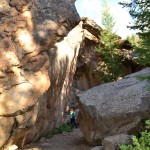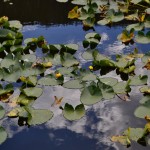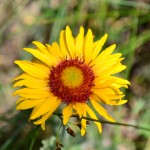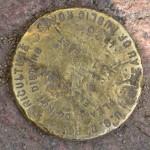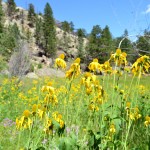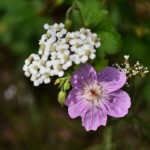Take a Walk
A Quest into the Wild
Mount Massive via Southwest Slopes: 14,421 ft

Distance: 8.06 miles (out and back) Elevation Gain: 4,037 ft. (net)
Max Elevation: 14,421 ft. Min. Elevation: 10,384 ft.
14er # 13
We drove once again into the land of the gentle giants a mere 6 days later to tackle our next objective in the Sawatch Range, Mount Massive. Massive stands majestically southwest of the little town of Leadville beckoning visitors and locals alike to touch her summit and rest a few moments in the third highest spot in the contiguous United States. Only Mt. Elbert next door and Mt. Whitney in California exceed her reach in the sky.
We began the trek with a Thursday evening drive into Leadville and fueled up at High Mountain Pies, a unique little pizza joint at 10,200 feet. We are constantly amazed that delicious food can ever be constructed at this elevation, but they have succeeded. After dinner, we were ready for the 30 min drive to our campsite near the trailhead after meeting up with our new hiking partner. This was a unique trip for us in the fact that we finally got to meet up with Spencer, founder of Mountain Obsession to tag a summit. Spence is on an over year long adventure trip living out of his car to explore and promote getting outdoors, being healthy and living a full life. We were pretty excited to get to share some of our backyard with him.
We set up camp near Halfmoon Creek about 2 miles from the North Halfmoon Creek TH which provides access to Mt. Massive via the Southwest slopes. We say set-up loosely as we car camped this time and forgot wood and chairs for a fire. Before it got dark, we wandered around near the creek and spotted a deer. Most of the time these guys are very skittish. Not this time. The deer followed us a bit and got a little too close for comfort.
Sleeping in the X-terra was cramped and cold. The night felt long until 5:00 am came around, and we wished we had some more sleep time. Mountaineering is always more difficult than it should be due to the lack of quality sleep most summit attempts afford. As the year progresses into fall, we are left with dark cold mornings in the mountains. We used flashlights and car lamps to prep in the inky early hours. We had 2 miles of tough 4WD road to clear to reach the trail. It took us about 20 minutes to get there. We advise not to take a 2WD or low clearance vehicle up this path. There are a couple of gnarly spots in the last 0.5 miles that were tough even with a 4WD decent clearance vehicle (2012 Nissan X-terra stock). We reached the trail just as the first glimmer of morning light began to appear. A memorial to the fallen soldiers in the Black Hawk Helicopter 2009 crash into Mt. Massive solemnly stood at the start of the trek.
The trek to Mt. Massive via the Southwest slopes begins very gently, passing through dense forest and lush vegetation for the first mile and a quarter. Several rains in the area during the proceeding days made the trail moist and muddy in a few places. During the first mile or so we gained very little elevation, probably only around 300 feet. There is a trail junction right after exiting the forest that leads into a meadow. Continue on the trail veering right (north), not left into the meadow. Heading left continues on to the North Halfmoon Lakes. The way leading up on these trails is almost always correct. Alpenglow was abundant as we edged the meadow and began to gain elevation.
Elevation gain began to get serious after the passing the meadow. We hiked vertically through a boulder field most of which provided decent stone steps. Although there were short bursts of loose scree in between the sturdy rock. The trail is a bit less apparent through here, but we had no real difficulty finding our way. Boulder fields continued until about 11,800 feet. We then proceeded up even steeper grades of trail in a grassy open area. The gain was brutal, but we had amazing views of the creek and surrounding valley below. A ptarmigan posed for us on a ledge. These guys are really difficult to catch a glimpse of due to their amazing camouflage.
We approached our first false summit at close to 14,000 ft. We were thrilled to be close to the summit ridge. Even though we were above 14,00 feet we were still not on Mt. Massive’s true summit. Massive is large and deceiving. There are many false summits on this large mountain which cloak her true summit. We continued up and around a corner before the summit ridge came into view.

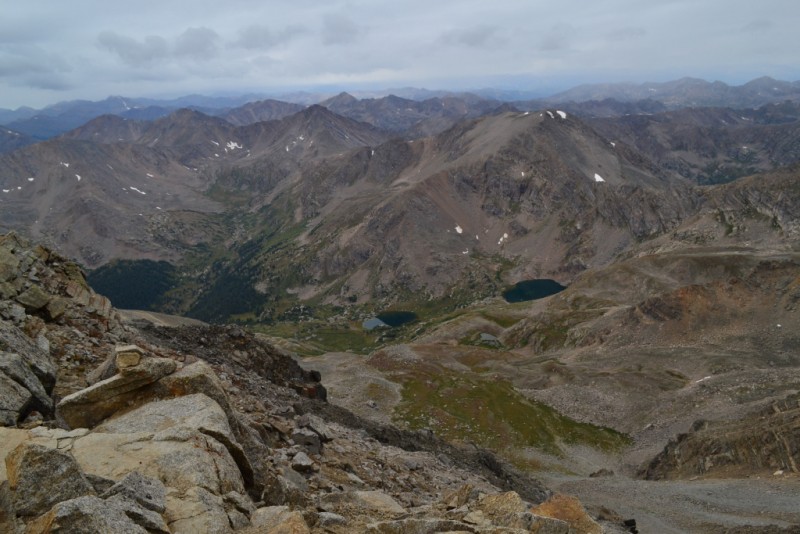
On the ridge the solid trail turns into some fun class 2 scrambling. It was very easy but really fun and more interesting than the long slog we had just endured. We climbed up a false summit that we originally thought was the highest point. We stood with two other hikers pondering this for a moment. Our GPS read 14,412 feet so we knew we needed to keep moving and tag the next point over. The final push seen below.
A few minutes later we tagged the summit. A lone hiker was resting on the summit with an Ohio University banner. She said she meant to climb Mt. Elbert that day but ended up at the wrong trailhead parking lot and said “oh well, I’ll climb Massive.” We were impressed since the Mt. Massive hike is a bit more strenuous and a much longer day than Mt. Elbert. There are some spontaneous and tough people in this state for sure. We enjoyed 15 minutes of relaxing, eating, and chatting before it started sleeting/snowing. The weather in Colorado is completely unpredictable. There was no rain or lightening which is an added benefit to hiking later in the summer season. We all had water proof shells and gloves and were good to go.
While frolicking across the ridge line was fun, our steep descent past the summit ridge was tough. Downclimbing 35 degree vertical scree is rough on the knees. Nonetheless, the Sawatch Range is so beautiful and impressive that it takes away from the discomfort. It is easy to inherent a powerful sense of human insignificance standing among the voluminous rock. Though surprisingly it tends to be more comforting than not.
“Mountains inspire awe in any human person who has a soul. They remind us of our frailty, our unimportance, of the briefness of our span on this earth. They touch the heavens, and sail serenely at an altitude beyond even the imaginings of a mere mortal”
Elizabeth Aston in “The Exploits & Adventures of Miss Alethea Darcy: A novel,” 2005.




As we approached the meadow and forest leading to our exit, we heard a voice call out from the reeds and willows. The voice called “hello” and “where are you?” and ask if we were heading on the proper trail to get out. Another testament to how easy it can be to become lost or disoriented on the trail if dehydrated and tired. She must have taken the junction to the North Lakes on her way down by mistake. After providing some direction, we whipped through the remaining 1.5 mile trail through the woods and made it back to our car. We after all had to get back to Denver to watch our Rockies take on the Giants.
All in all a good summit day. Here are a few parting words of advice if you plan to take the southwest slopes.
- The RT length of the trail is 8 miles on the Southwest slopes route versus 14 on the standard route. This doesn’t mean this route is easy. Most of the elevation gain is crammed into about 2.5 miles of steep uphill fun.
- To get to the North Halfmoon trailhead you must take a 4WD road for just over 2 miles. There is no way a 2WD low clearance vehicle could do certain parts of this road without damaging the vehicle. The worst part of the road is about 0.3 miles from the trailhead. It was tricky in the X-terra but we made it fine. Plan on a longer hike if you don’t have a high clearance ride.
- There are a ton of great campsites all throughout the Halfmoon Creek area. They have places to park, pitch a tent and most contain fire rings.
- Beware of two trail junctions on the trek to the summit. The first occurs after about 1.25 miles. Veer right (north) and head up on a less defined trail rather than left into the meadows which leads toward the N. Halfmoon lakes. The second junction is located on the summit ridge. It is where the standard route connects with the southwest ridge route. Just make sure you don’t take the standard route back down. That would lead to an extremely long hike back to your car.
Writing by Allyson Sandifer Checkley
Photography by Thomas James Checkley
Mount of the Holy Cross via the North Ridge Route

Distance: 12 miles (out and back) Elevation Gain: 5,649 ft. (total)
Max Elevation: 14,005 ft. Min. Elevation: 10,311 ft.
For years, rumors circulated that a natural cross could be found deep in the rugged back country of Colorado. Until photographer W.H. Jackson produced the famous photograph in his geographical survey expedition with F.V. Hayden in 1873, the existence of the beautiful religious symbol was just speculation. The beautiful image taken just after dawn from Notch Mountain erased any doubts. The natural cross of snow lays across the rugged face of the mountain formed by two deep ravines and has been tempting hikers, nature enthusiasts and pilgrims ever since Hayden and Jackson’s famous expedition. While the mountain and surrounding wilderness has been the subject of beautiful poems, famous paintings, and a place of prayer, it has also been a place of tragedy. Since 2005, there have been two deaths, one presumed, as no trace of the hiker has ever been found. Every year numerous hikers have required rescue after becoming lost, and The Gazette of Colorado Springs has gone so far as to have called it “the Bermuda Triangle of Colorado.” In fact, a member of Vail Mountain Rescue Group we encountered on the summit ridge told us they have already had to assist 6 climbing parties that have become lost on the descent this season.
The allure of Holy Cross has not eluded us either. The mystery, intrigue, and challenge of the mountain finally pushed us towards a summit attempt on the last week of August. Mount of the Holy Cross stands prominently in the northern portion of the Sawatch range at a height of 14,005 feet, just making the cut-off for an official Colorado “14er”. To reach the summit trailhead, we drove to Minturn which is just south of Vail. From Hwy 24 we took a right on Tigiwon Rd. and followed the rocky dirt road 8 miles. We tent camped at the Halfmoon campground and enjoyed a quiet (well almost) night under the stars. Seen below are photos of our arrival in Minturn, our campsite and the brilliant night sky.
We tucked in for the night at around 10:00 pm. Shortly after, we were awakened by a violent thunderstorm. The lightning lit up the sky brightly. Every minute or so another loud clap of thunder sounded, and then the rain began. We huddled under the protection of our tent and prayed that the canvas would keep us dry. We eventually fell asleep, and the tent thankfully kept us dry until morning. The alarm went off at 4:15 am, and we slowly got packed up and ready without a full night’s rest. We donned our head lamps in the darkness of the cold early morning and hit the standard North Ridge trail. Fortunately, the sky was clear and the storms had ceased. We quietly hiked for 1.5 miles in the dark towards Half Moon pass. We gained about 1,300 feet of elevation during this early morning portion, but the darkness has a way of hiding the ascent and thus it went by quickly and without much notice on our part. As we approached Halfmoon pass the sun started to rise revealing a thick layer of fog below us. The moist air looked like a waterfall rolling over the thick treeline in the distance.
Utilizing the North Ridge route requires climbing Half Moon Pass and then descending into East Cross Creek thereby losing a bunch of elevation before gaining the summit of Mount of the Holy Cross. In fact, many hikers choose to attempt the summit in two days by camping at East Cross Creek to minimize the daily elevation gain. As we descended the pass, we gained our first views of the distinct and exquisite mountain. Unfortunately, the cross cannot be seen from the route we took. In order to gain a view, the Halo Ridge route via Fall Creek and Notch Mountain trails must be taken. In addition, the cross is not well visible during the late summer months as much of the snow has melted out. We plan to attempt the more demanding Halo Ridge early next season or at least climb to the Notch Mountain shelter to get a great view. The first photo below reveals alpenglow on our first view of Mount of the Holy Cross. The second photo was taken during our return to give some perspective of the distance necessary to reach the summit.
The descent into East Cross Creek proved to be very steep. After about a mile of down climbing, we finally reached the creek crossing and all the backcountry campsites. After crossing the creek, the trail began to regain elevation. We followed several steep switchbacks to treeline.
After treeline the real challenge began. From the creek to the summit we gained approximately 3,330 feet of elevation in 2.7 miles making for an average grade percent of around 23. However, we encountered a mile of 30% grade incline before reaching the ridgeline, and another 30-35% grade incline in the final 0.35 miles to the summit. Seen below are photos taken just after treeline while we pushed for the ridgeline. The summit of Holy Cross can be seen in the background.
With each foot of elevation and distance gained we got to see a little bit more of Holy Cross. Despite our progress, her summit still looked impossibly far away. The trail above treeline was very rocky and consisted of many stone steps and rocks. Route finding was not necessary at this point due to all the work the Colorado 14er’s Initiative has been doing maintaining the trail. Once we reached the ridgeline the incline of the trail mellowed out briefly, and we were able to enjoy the impressive views of the mountain and surrounding wilderness. This was a wonderful portion of our ascent. A layer of fog surrounded the summit of Mt. of the Holy Cross for a brief 15 minutes. We captured the moment below.
Just before the crux of the route we passed the Angelica Couloir on our left. There was no snow in the couloir at the time of our trek (August 28th), but this is probably a really great route when snow is present. After the couloir the trail ends, and the remaining route is a fun scramble through large talus. This is a good place to practice route finding skills as there are many ways to get to the top. We chose to veer more towards the right side to stay away from the steep drop off of the couloir. We scrambled up about 300 feet and joyfully tagged the summit marker. We were the only ones on the summit for about 20 minutes. It was mountaineering bliss. We set the camera up to autoshoot and took a few photos. The lake in the bottom photograph is the Bowl of Tears. This beautiful lake serves as one of the headwaters of Cross Creek and rests at about 12,000 ft. Fisherman take heed: sources say there are no fish in the lake.
After spending about 30-40 minutes on the summit, we decided to head back down. This was the first time in a while that the weather was stable and beautiful allowing us to actually enjoy our time on top of the mountain. After much research and reading about various lost hikers, we were very cognizant of our route. Many hikers have taken the incorrect descent of Mt. of the Holy Cross. Instead of veering right and following the ridgeline some hikers miss the turn and head straight down the mountain which leads into a vast wilderness. There is also a cliff band in one spot. Quite honestly we were surprised this was a common mistake. We had no trouble finding our way back. On our descent we did take a route closer to the couloir to save time. Perhaps if we were really tired and dehydrated we could have made the mistake. We did study and plan the route really well prior to the hike and brought a map and GPS just in case to avoid any mishaps. Nonetheless, the sheer size of the wilderness area of Holy Cross is amazing. It would not be difficult to become lost or disappear if not properly prepared.
We took our time on the descent, enjoying the wonderful views the ridgeline has to offer. Directly across the summit and visible from the ridgeline is the semi-famous Notch Shelter located near the summit of Notch Mountain. It was built in 1924 as a stone shelter for visiting pilgrims to spend the night and awaken to the illumination of the cross come morning first light. Today it still stands though it is somewhat run down. It has been equipped with lightning rods to protect hikers on the ridgeline in the event of a thunderstorm. Camping is no longer allowed in Notch Mountain Shelter. The shelter can be seen distantly in the photograph below.
On our descent we encountered a few more hikers ascending, perhaps 8 total. Our early start let us have the whole mountain to ourselves for most of the day. This was the most isolated 14er we have done so far and one of our favorites. We took our time and relaxed on a warm sun-baked boulder on the way down. We refueled with some peanut butter and Gatorade. The sun still shone brightly and the sky was still peacefully blue. We crossed back over the creek and mentally prepared ourselves for the uphill climb back over Half Moon Pass. Contrary to logic, we hiked the quickest we had all day to get back over the pass. While it wasn’t exactly pleasant, it wasn’t quite as bad as most people make it sound. Seen below are photos of the climb back up and out.
It was dark when we first climbed Half Moon Pass. Thus, on our return down to the truck it was like a completely new hike. We were greeted with beautiful meadows of wildflowers and lush greenery.
We reached the truck mid-afternoon and quickly headed into Minturn for an early dinner at Kirby Cosmo’s BBQ to celebrate. We had finally visited Mt. of the Holy Cross after 2 and a half years of talking about it. We completed the standard North Ridge route this time around. We are by no means done exploring this area. Next time we would like to try the Halo Ridge Route, or even just climb to the Notch shelter. There are so many hidden gems to find in Holy Cross wilderness beckoning the curious outdoorist to come explore.
Writing by Allyson Sandifer Checkley
Photography by Thomas Checkley
McCullough Gulch 2015
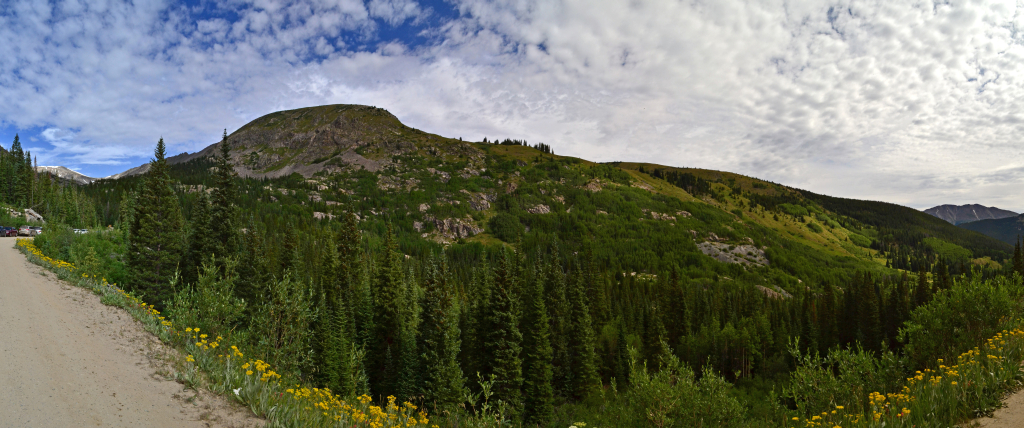

We decided to hike McCullough Gulch again, but this time with different company: Thomas’ Mom. Last year we hiked McCullough Gulch on a trip for Allyson’s birthday and the trip report can be found here: McCullough Gulch 2014. This year’s hike brought new adventures and excitement.
The hike itself is roughly 2.7 miles RT to the Blue Reservoir, but it can be longer or shorter depending on what you want to do. At the trailhead the trek begins at roughly 11,102 ft and at the lake the elevation is approximately 11,936 ft, all according to our Garmin GPS, for a net elevation gain of about 834 ft. It is a short and easy hike relative to it’s neighboring hike of Quandary Peak, which looms next door for the entire jaunt of McCullough Gulch; but is still above 11,000 ft and there are some rocky and steep areas making it not a walk in the park.
The hike begins with an 18-20% grade up an old mining trail. There are views along the beginning to be had if you are looking to take your time, which we were. After passing an abandoned mining area there is a natural scenic overlook formed by an outcropping of large boulders. We stopped here for a photo-op and to enjoy the scenery. Below are some of the images from the scenic overlook and the initial start of the hike.
The hike continues to rise until about 2/3 of a mile and then flattens out a bit as the trail narrows through pine trees. Mom started to notice that outer-sole of one of her boots was coming off, which was not ideal. Her boots were a bit old according to her, perhaps 18 years old. Eventually, the outer-sole of the boot did come off completely, and she walked more than half of the hike on the mid-sole of the boot. Lesson learned: check your equipment before you hike! Below are some pictures of the flat section and of her boots.
After going up for a little while you reach a small talus field, which has a nice, clear path leading through it. Just after this is a small single beam bridge over a creek (pictured above bottom left), and just after this bridge you reach a crossroads. You can either continue making your way up to the Reservoir by veering to the right, or take a small detour loop to the White Falls by aiming to the left. We wanted to see the Falls — because they are really very majestic — and so we took the quick detour. Some pictures of the Falls are below.
The Falls trail loops back around rejoins the McCullough Gulch Trail shortly after the falls and the trail begins to steeply rise again towards the Reservoir. There is only about a third of a mile from this point to the Reservoir. Along the way you can see Quandary Peak looming to the left along with an array of gorgeous wildflowers. The rock can be a little loose and it is important to watch your footing here, especially if you aren’t a regular hiker; but the goal is just around the corner. Mom was having some trouble here on some of the rocky parts due to her outer-sole coming off and having very little grip on her left foot. This tells us that having shoes with good grip, either trail running shoes or hiking boots, are nice to have for this hike. Below are some pictures from this portion of the journey.
After one last push up a rocky portion of the hike the view of the Reservoir appears and you have made it. As you approach the lake there are at least three options to be had, not all exclusive to one another. There is an option to take a left turn and hike across the outflow of the Reservoir, a small creek pictured below, and onto a hill on the Quandary side of the Reservoir. This area gives great views of the Reservoir and is often inhabited with mountain goats. In fact, the day we went there was a herd of mountain goats on the hill with a baby mountain goat in tow. It was really awesome to see the mountain goats, and especially the kid.
Mountain goats are typically not aggressive to humans, but there have been attacks on humans and at least one fatality. See this article from Backpacker.com about a man who was gored by a mountain goat in Olympic National Park. Even so, it is never wise to approach wild animals and it is illegal to feed any wild animals. It is in everyone’s best interest — hikers and animals — to keep a safe distance from wild animals. Below are some pictures of Blue Reservoir and the mountain goats (for reference I used 200mm lens and cropped the resulting images for the mountain goat shots).
The hill also lends itself to taking a nice panorama of the cirque and Reservoir, which we did! Mom stayed on a rock and had a nice time refueling and enjoying the scenery while we explored the area. In fact, if you click on the image below, and zoom on the large rock on the right side of the Reservoir you can see a person wearing a black jacket, that is Mom! What is also nice about the image below is that you can see the path leading up to that large rock. If you so desire, you can keep following that path past the Reservoir and towards a group of three lakes higher up (the path is visible from Google Maps). If you choose to explore these upper lakes, be aware that it turns this hike into a 6 mile RT hike from a 2.7 mile RT hike. As far as I know these upper lakes are not officially named.
The hike back down was pleasant, but the mosquitoes were out and that kept us moving. We would recommend bringing spray to keep the bugs at bay. This is a very nice hike, especially for beginners, and can be used as a trail run, which Thomas did the following day. It is a very versatile trail, and you can spend well under an hour running the trail to a half day exploring and taking pictures; to top it all off it is next to the very friendly town of Breckenridge, where we spent the remainder of our excursion.
Photography and writing by Thomas Checkley
Cub Lake, The Pool, and Fern Falls: Rocky Mountain National Park

We’ve been to Rocky Mountain National Park many many times before, but have only explored a small fraction of what her 415 square miles have to offer. After a tough climb above 14,000 feet the prior weekend, we were craving some relaxing lower elevation exploration. And when we say lower elevation, we mean 8,000 to 10,000 feet above sea level. Our destination on this particular jaunt into the park was Cub Lake in the Moraine Park region on the eastern corridor of RMNP. The Cub Lake trailhead sits just above 8,000 feet about half a mile off Moraine Park Rd., which is accessed via Bear Lake Road. We arrived on a late July Friday afternoon at about 2:00 pm to avoid the earlier summer and weekend crowds, and we were able to find a decent parking spot. Our hike began with a bridge crossing of the Big Thompson River and continued onward skirting the western side of Moraine park. The elevation gain was minimal to non-existent for the first mile or so of the hike. We enjoyed the easy stroll and admired the plethora of wildflowers along the way. Seen below are photos.
The sun was high and the temperatures warm, and we were ready to gain some elevation and get a cool breeze. Eventually we ended up following the Cub creek and stumbled upon several small ponds before the trail was engulfed in a grove of aspens and ferns. Everything was green and lush. The landscape almost resembled something tropical. In fact, the insect life along this trail did in fact resemble the tropics. We battled large mosquitoes along much of the trail. Past this portion of the hike, we began to notice the remnants of the 2012 Fern Lake fire. Instead of beautiful alpine forests, we saw charred branches, dead trees, and meadows in place of alpine forests. Unfortunately, someone made an illegal campfire (backcountry campfires are not permitted in RMNP) and the steep terrain and pine beetle infestations made it catch very quickly. According to website data, the fire engulfed nearly 3,500 acres before an early season snowstorm quieted it. Seen below are photos.
Nonetheless, the wildflowers, animal and plant life among the charred trees reminded us that ecosystems are equipped to adapt and sometimes fire can lead to biodiversity and support the natural progression of the environment. After about 2.3 miles, we reached Cub Lake. While Cub Lake isn’t as striking as many of the other high alpine lakes found in RMNP, it’s quiet beauty is a worthy hiking goal. In summer, the lake is covered in the thick green of lily pads. Marshy banks surround the lake, but a few large boulders on the north shore make a nice place to sit and relax. Seen below are photographs from Cub Lake, our first destination of the day.
Instead of returning the way we came, we continued northwest on a one mile connector trail leading to The Pool. We quickly gained a bit of elevation, which provided sweeping views of Cub Lake below. The trail then descended sharply into Forest Canyon. After the quick downhill, we reached the Pool and the Fern Lake Trail. Instead of completing an out and back hike, we opted to make a loop and hike back to our truck via the Fern Lake Trail. There were many other hikers at the Pool, which is easily reached via the 1.7 mile Fern Lake TH. Essentially, the pool is a continuously churning bit of water fueled by falls from up river. It is quite a pretty site, but not the most exciting of destinations in the park in our opinion.
We still had plenty of time and daylight at The Pool, so instead of returning we proceeded to follow the Fern Lake Trail further out towards Fern Falls and Lake. Just before reaching the Falls, we ran into two hikers who said they had just encountered a black bear about 10 min past the Falls. They mentioned he/she didn’t retreat and they were afraid to continue towards the lake. We heeded their advice and stopped at Fern Falls. Fern falls is quite spectacular and well worth the additional mile ascent from the Pool. Seen below are photograph of us enjoying Fern Falls.
We encountered a few hikers coming down from Fern Lake while we relaxed at the Falls. Many of them had seen the bear and claimed it was just foraging and didn’t bother them. Thankfully the last grizzly bear to be seen in Colorado was in 1979. However, we are not anxious to run into a black bear on the trail. After 15 or so min, we returned to the Pool and proceeded back via the Fern Lake Trail. The Fern lake trail was mostly downhill towards the parking lot and led us through a dense forest of aspen and lodgepole pine. The trail followed along the Big Thompson River, and eventually led us to Arch Rocks which is a large collection of boulders of interesting shapes and sizes planted next to the river. We were unaware of this unique formation when we set out on the hike and were pleasantly surprised. Seen below is a portion of the Arch Rocks.
We continued for about 1.7 miles until we reached the Fern Lake TH. Unfortunately, this meant we would have to hike 1.2 miles on a dirt road to get back to the Cub Lake trailhead. The mile went quickly, and we made it back to the Cub Lake TH and our truck in no time. According to Garmin our loop hike was 8.6 miles. While we enjoyed this hike, it does not offer the same high alpine experience that many other lake destination hikes do in RMNP. Despite this, if you have multiple days to spend in the park, especially in the fall when the aspens are changing and the elk are bugling, Cub and Fern Lake would be a great viewing spot.
Writing by Allyson Sandifer Checkley
Photography Thomas Checkley

